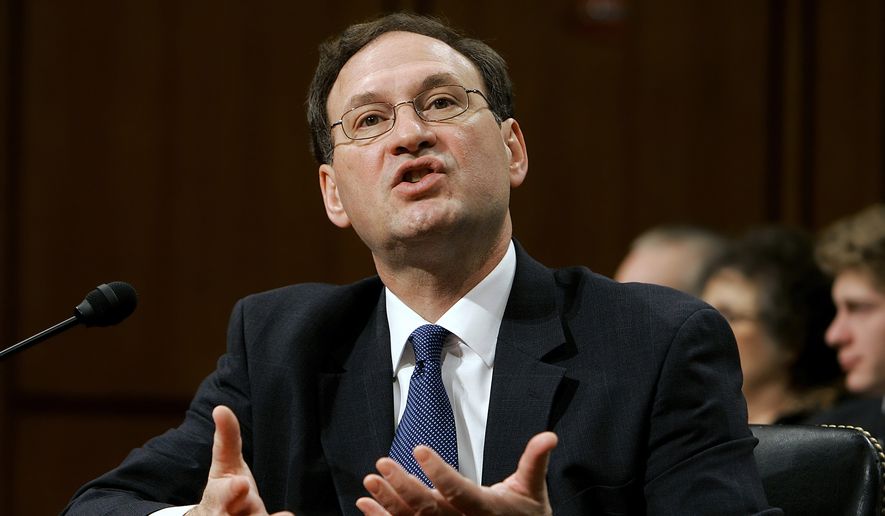OPINION:
Much that has been said and screamed from Congress and on the streets about Justice Samuel A. Alito Jr.’s draft opinion striking down the constitutional right to an abortion is either false or misleading.
It is simply not true that Justices Neil M. Gorsuch, Brett M. Kavanaugh and Amy Coney Barrett lied during the confirmation hearings.
They merely stated the obvious. Roe (1973) and Casey (1992) — which established a constitutional right to an abortion without undue burden imposed by state regulations — are precedents. But stare decisis has never implied perpetual deference.
Justice Alito’s decision persuasively argues Roe was terribly flawed in its legal reasoning — much like Plessy (1896), which enshrined segregation until Brown (1954). Instead, it reasonably asserts rights guaranteed by the Constitution must be enumerated or “deeply rooted in this Nation’s history and traditions.”
The Constitution makes no mention of abortion, and prohibitions go back many centuries in common law and more recently in state statutes. It is not the place of nine justices — philosopher-kings selected from only two law schools in liberal New England — to invent rights from penumbras, emanations or the blue haze of cannabis lofting above a law school dormitory on a Saturday night.
Americans remain deeply divided but hardly absolutists. In 1975, a Gallup Poll reported that 21% favored legal abortions, 22% opposed them, and 54% said they should be legal in some circumstances. Last year, those numbers were 32%, 19% and 48%.
This decision won’t undermine court decisions creating rights for gay marriage, contraception and interracial marriage. Like abortion, none of those rights when the Supreme Court acted could be construed as having enjoyed a strong basis in the “Nation’s history and traditions,” but public views have radically changed in recent decades.
Whatever misgivings individual citizens may harbor for application in their personal lives, most Americans now view these issues as matters of personal choice.
The Alito decision does beg the question of how much polling data should move the courts to proclaim rights before state legislatures act. Electorates vary in their dispositions by state. Representatives can be voted out, but judges generally can’t.
In many rural and southern states, abortion either will be illegal or, more likely, tightly regulated, and many women will have to travel to populous states like California, New York or Illinois.
Charitable institutions, just as they now help women find abortion clinics, in many instances will provide support for their journeys. Medical abortions, currently the choice in more than half of all terminations, will continue to be available — even if women have to send out of state for the pills.
Doctors and emergency rooms won’t be able to directly supervise in states prohibiting the sale of these drugs, but medical providers who are so disposed will find ways around restrictions to be on the ready to treat adverse side effects.
Stopping prescription meds from moving across state lines is darn difficult, and abortion pills send fewer people to emergency rooms than Tylenol or Viagra.
Waving wire hangers on the steps of the Supreme Court is a great way to garner the outrage of women and men who have not matured intellectually beyond adolescence, but the world has changed since 1973 — easy access to birth control and medical abortions make such demonstrations hysterical.
Currently, the speaker of the House, secretary of the Treasury, CEOs of General Motors and Citibank, presidents of many of our most prestigious universities, voices in the media and leaders in countless other institutions are now women.
They will not disappear if the draft of the Alito decision becomes final. Women — along with men — will continue to decide policies about who gets hired, fired, admitted and rejected.
With access continued secure and inexpensive, birth control will be more heavily used in places where abortion is more difficult or impossible. While more children will be born to the poor, the progress of women will generally continue largely unimpeded.
What will be interesting to watch is how strictly the Supreme Court now limits the arrogation of power both by the courts and the executive branch. For example, the precedent established by Chevron (1984) permits federal agencies to regulate aggressively in places where statutes are vague or silent — such as on affirmative action and climate change.
But by apparently safe harboring Griswold (1965) and Obergefell (2015), which overturned prohibitions on contraception and gay marriage, the Alito draft decision would indicate abortion decision is more of a special case than a reason for great celebration by conservatives and originalists.
The philosopher kings will continue to create myths — for example, that the fine in the Affordable Care Act for not subscribing to health insurance was really a tax — until we have a constitutional amendment that defines the limits of judicial supremacy.
• Peter Morici is an economist, emeritus business professor at the University of Maryland, and a national columnist.




Please read our comment policy before commenting.